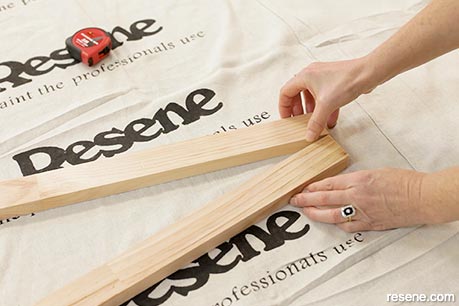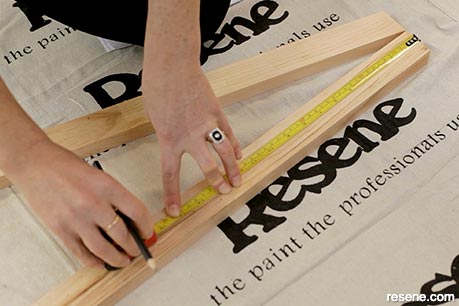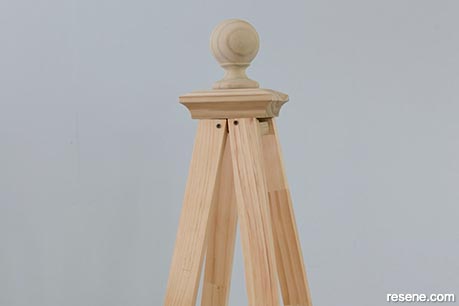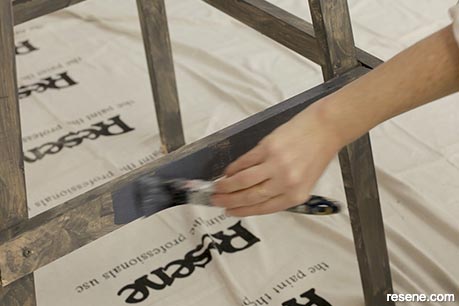From habitat magazine - issue 37, step by step
Create garden art that’s aged to perfection with Resene FX Faux Rust Effect.

This wooden obelisk is great for climbing roses, sweet peas or climbing edibles such as beans.
To create the rusty look, the wooden structure was painted in Resene FX Faux Rust Effect basecoat followed by Resene FX Faux Rust Effect activator. Just like real rust, the rust colour will develop over time. Fence painted in Resene Element CoolColour.
Resene FX Faux Rust Effect transforms non-metal surfaces into the look of corroded or weathered steel. In this case, a wooden structure built from battens and timber offcuts becomes a rusted-looking obelisk, ideal for growing climbing plants.
![]() The Resene FX Faux Rust Effect Activator is corrosive. When applying close to any adjacent metal surfaces, ensure plastic covers are in place to protect the metal surfaces against contact.
The Resene FX Faux Rust Effect Activator is corrosive. When applying close to any adjacent metal surfaces, ensure plastic covers are in place to protect the metal surfaces against contact.
 Step one
Step one
Using the protractor, mark an angle of 8° at the top and bottom of each of the 1800mm-long pieces. Cut the angle with a bench or hand saw.
 Step two
Step two
Working on a flat surface, form an A-shape with two 1800mm pieces, joined at the top, and with 650mm at the base (measured from the outside). Place the support pieces on the frame at the following distances (measuring from the top): 400mm for the smaller support, 865mm for the middle support and 1035mm for the longest support. They will overhang at the edges.
 Step three
Step three
Mark with a pencil where the supports sit on the frame for easy placement later, then mark the angle on the underside of each support where the wood needs to be cut to line up with the frame. Remove from the frame and cut the angles with a hand or bench saw.
 Step four
Step four
Using a 4mm drill bit, drill pilot holes at each end of the supports where they are to be screwed to the frame. Then screw supports in place. Repeat steps 2 to 4 to create the other side of the frame.
 Step five
Step five
Take the 80mm x 80mm piece of timber and cut each side at an 8° angle to form a support for the A-frame at the top. Place one side of the A-frame on top of the 80mm support (as shown), drill pilot holes and then screw in place. The support piece should be flush with the top of the frame.
 Step six
Step six
Turn the frame and support piece over, place the other side of the A-frame on top and prop up at the end to a height of about 640mm. Drill pilot holes into the frame and support piece, then screw into place.
 Step seven
Step seven
Place the remaining side supports on the frame and mark the angle on the underside of each support where the wood needs to be cut to line up with the frame. Remove from the frame and cut the angles with a hand or bench saw. Attach to the frame: drill pilot holes first, then screw them into place.
 Step eight
Step eight
Screw the fence-post cap to the top of the support piece from beneath.
 Step nine
Step nine
Paint the obelisk. Apply two coats of Resene FX Faux Rust Effect basecoat using a brush, allowing at least four hours’ drying time between coats. Use random brushstrokes in different directions to create an uneven texture to enhance the look of the rust.
 Step 10
Step 10
Apply two coats of Resene FX Faux Rust Effect Activator to the obelisk using random brushstrokes in different directions, completely covering all of the basecoat. Allow the first coat to dry before applying the second.
 Products used
Products used
The Resene products used to give the garden art a rust effect finish.
 Close-up of finish
Close-up of finish
A close-up of the rust effect finish on the garden obelisk.
top tip Apply Resene FX Faux Rust Effect Activator within 24 hours of applying the basecoat, ideally when the Resene FX Faux Rust Effect basecoat is tacky or touch dry. Rusting will start to develop within 12 hours. The final colour may be protected (not sealed) by applying two coats of Resene Aquapel waterborne diluted 2:1 with water.
› For a video on how to make this obelisk, visit www.habitatbyresene.com/obelisk.
Project: Jane Wrigglesworth
Images: Bryce Carleton, Ben Whorwood
Search habitat magazine stories
Printed copies of habitat highlights are available from late March 2024 at Resene ColorShops and resellers, while stocks last. You can view back issues of habitat magazine online.
Specifiers:
If you have an idea, project or story that you think would suit habitat, we’d love to hear from you. Please drop us an email with your details and include photos if submitting a project.
Sign up for a DIY card and Save! Australia | New Zealand